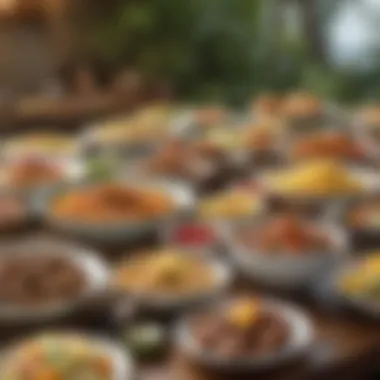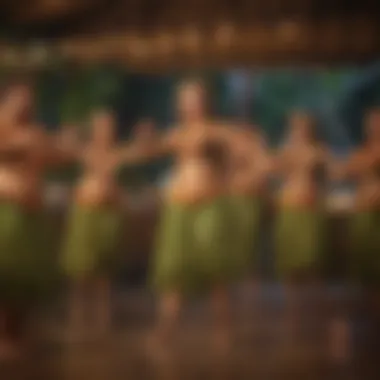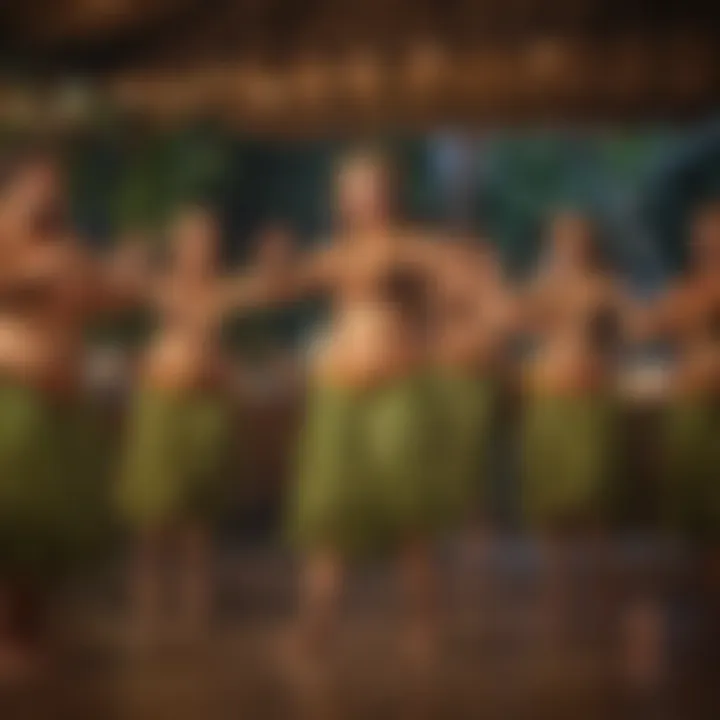Essential Guidelines for Your Luau Party Planning


Intro
Planning a luau party requires significant thought and organization. This event is not just a gathering; it is a celebration rich in culture and tradition. To create an authentic experience, hosts need to consider multiple factors, from the venue and cuisine to activities and decor. Understanding these elements can enhance the enjoyment of guests and evoke the spirit of Aloha.
Traditionally, a luau originates from Hawaii, where it serves as a feast filled with cultural significance. Today, many use this concept to celebrate special occasions or simply enjoy good food with family and friends. A successful luau party brings together essential components that contribute to the festive atmosphere. Host's effort and attention to detail lead to memorable moments for all attendees.
We will explore various aspects of organizing such an event, ensuring each component aligns with the overall theme. From selecting an enticing menu to engaging activities, all these elements must work in harmony. This guideline aims to provide clarity to those who wish to dive into the art of hosting an enchanting luau party.
Recipe Overview
Recipe Name and Description
A traditional luau feast often features dishes such as Kalua Pig, which is slow-cooked in an underground oven known as an imu. This dish is characterized by its smoky flavor and tender texture. It is accompanied by side dishes like Lomi Salmon, fresh Poi, and various tropical fruit salads, creating a colorful and delicious spread for guests to enjoy.
Cuisine Type
The cuisine for a luau party falls under Hawaiian and Polynesian. These dishes reflect tropical ingredients such as taro, coconut, and a variety of fish, showcasing the region's rich culinary heritage. Moreover, the presentation plays a role in enhancing the vibrant experience of the luau, where food becomes a visual delight.
Ingredients List
Detailed Ingredient Breakdown
To prepare an authentic luau menu, the following ingredients are essential:
- Kalua Pig: Pork shoulder, Hawaiian sea salt, liquid smoke
- Lomi Salmon: Fresh salmon, tomatoes, green onions, salt
- Poi: Taro root, water
- Tropical fruit salad: Pineapple, mango, papaya, lime juice
Each ingredient reflects the traditional flavors of Hawaii, ensuring the party maintains an authentic taste profile.
Substitutions for Dietary Needs
Not all guests may share the same dietary preferences. It's vital to consider substitutions:
- For Kalua Pig, a plant-based version can use jackfruit for those preferring meat alternatives.
- Lomi Salmon can be adapted to a vegetarian option using tofu.
- To substitute Poi, mashed sweet potatoes can serve as an alternative for those who may not like taro.
Mindful planning helps cater to diverse dietary requirements, ensuring no guest feels excluded from the enjoyment.
By adhering to these guidelines, hosts will be equipped to plan an event that celebrates Hawaiian culture while providing a festive atmosphere. These careful considerations will go a long way in creating lasting memories for both the host and guests.
Preface to Luau Parties
The concept of a luau party is deeply woven into the fabric of Hawaiian culture and traditions. Typically associated with celebration, luaus exemplify community gathering, showcasing food, music, and dance that mirror the essence of Hawaiian life. Understanding what a luau is about is crucial for anyone looking to host a successful event.
Historical Significance of Luau
Historically, luaus originated as a way to celebrate significant events. They served not just as parties but also as rituals tied to various cultural and spiritual practices. The gatherings were often held to commemorate a victorious battle, a birth, or even significant life changes. Traditionally, these events included communal feasting, where everyone participated in the preparation and enjoyment of the food.
The meaning of luaus has evolved over the years. While they still retain their celebratory aspects, the modern interpretation often emphasizes hospitality and inclusiveness, which reflects the Aloha spirit. This is important to note, as it sets the tone for any luau party today. Recognizing this historical context enriches the planning process and allows hosts to pay homage to these traditions while creating a memorable experience.
Cultural Elements of a Luau
A luau is not merely about food and drink; it is an intricate tapestry of cultural elements that enhance the ambiance and authenticity of the event. Integral components include traditional music, dance, and decor.
- Dance and Music: The hula dance and chants, known as mele, form the heart of any luau. Their rhythms and movements tell stories about love, nature, and history. Inviting performers can elevate the experience, providing guests with a glimpse into Hawaiian heritage.
- Food: Traditional dishes are essential as well. The presence of Kalua pork, poi, and tropical fruits reflects the island's bounty. Ensuring that these items are part of the menu is key to an authentic luau experience.
- Decoration: The visual aspects of a luau also play a substantial role. Using tiki torches, flower leis, and vibrant table settings helps create the right atmosphere. Each element contributes to a feeling of being transported to Hawaii for the duration of the event.
In summary, understanding both the historical significance and cultural elements of a luau party is vital for planning. They not only inform the choices made in terms of food and decor but also the spirit of community and celebration that should pervade the entire event.
Choosing the Right Location
Choosing the right location for a luau party is crucial for creating an authentic and enjoyable atmosphere. The setting influences the overall experience, affecting not just aesthetics but also comfort and participation levels of guests. Therefore, careful evaluation of the venue is necessary to ensure it aligns with the festive spirit of a luau.
Outdoor vs. Indoor Luau
When deciding between an outdoor or indoor luau, both options have unique advantages. An outdoor setting often provides a more natural and inviting environment typical of Hawaiian scenery. Elements such as fresh air, grass, and possibly a view of water can enhance the experience immensely. However, indoor venues offer control over climate and logistics. This becomes significant if unexpected weather events might disrupt an outdoor celebration. Thus, the choice largely hinges on availability, type of ambience desired, and weather forecasts.
Factors to Consider for Location
Space Availability
Space availability plays a vital role in planning a luau. The selected area must accommodate all guests comfortably, allowing freedom of movement for activities, dining, and socializing. A spacious environment is also crucial for setting up food stations, games, and performance areas without feeling overcrowded or cramped. Depending on party size, venues with both large indoor and outdoor areas are particularly beneficial, allowing flexibility while fostering a festive atmosphere. An expansive venue enables hosts to provide various experiences that would engage guests more profoundly.
Accessibility
Accessibility is another crucial aspect when choosing a location. The venue should be easy to reach for all guests, with ample parking or public transport options available. This characteristic ensures that no one feels deterred due to travel burdens. A venue nestled in a more isolated area might provide picturesque scenery but could complicate logistics. Therefore, hosting the event at a location reachable for everyone should always take precedence. Enhancing accessibility not only aids in guest attendance but also promotes a smoother flow of events during the party.


Weather Considerations
Weather considerations can greatly impact the success of the luau. An outdoor party must consider seasonal changes, as rain, wind, or extreme temperatures can disrupt the festivities. Choosing a time of year with predictably favorable weather will boost confidence in the planning process. It may also be prudent to have a backup plan in case unforeseen weather events occur, such as reserving an indoor area as an alternative. Being prepared for various conditions safeguards the event and maintains the atmosphere of enjoyment and celebration.
The right venue can set the tone for an unforgettable luau party, merging comfort and enjoyment seamlessly.
In summary, selecting the right location requires thoughtful consideration of the benefits and drawbacks of outdoor versus indoor settings. Space availability, accessibility, and weather factors should lead the decision-making process, ensuring a memorable experience for all attendees.
Budgeting for the Event
Budgeting serves a fundamental role when organizing a luau party. It is vital to map out expected expenses to avoid financial strain and ensure that all aspects of the event are adequately addressed. Effective budgeting allows hosts to allocate funds appropriately across different areas, ensuring an authentic and a memorable experience. Understanding costs not only aids in decision-making but also helps to set realistic expectations for the event.
Identifying Key Expenses
Venue Costs
Venue costs form a significant portion of the overall budget. This expense often encompasses rental fees, setup charges, and possibly cleanup costs. Choosing the right venue affects the ambiance and comfort of the guests.
Fields like backyards or parks can serve as affordable and flexible options, while dedicated event spaces may enhance the festive atmosphere. Each choice has its benefits and drawbacks. External venues might provide unique settings but usually come with higher price tags. Thus, understanding this aspect helps create a balance between budget limitations and desired atmosphere.
Food and Beverages
Food and beverages are the heart of any luau party. Guests expect a variety of dishes that reflect Hawaiian cuisine, which can involve substantial financial commitment. Including options like Kalua pork and poi adds authenticity to the event.
However, balancing traditional offerings with cost considerations is crucial. Often, buying ingredients in bulk or sourcing from local markets can help reduce costs. A well-planned menu can enhance the overall experience while keeping expenses in check.
Decorations
Decorations are essential for fostering an immersive luau atmosphere. From tiki torches to colorful table settings, these elements contribute to the visual appeal of the event.
However, this category can quickly escalate in cost, especially if relying on professional decorators. Hosts can save money by opting for DIY decorations, which add a personal touch. Understanding the specifics of decoration costs ensures a lively environment without overspending, creating a welcoming space for all attendees.
Cost-Saving Strategies
DIY Decorations
DIY decorations present a practical strategy for budgeting. They allow hosts to express creativity while significantly reducing costs. Creating handmade items such as leis or banners can engage the hosts and attendees, adding a personal touch.
The key characteristic of DIY ideas is their adaptability. Hosts can tailor decorations to their vision without the premium that often comes with professional services. However, it is crucial to balance this with time commitments, as making decorations can be time-consuming.
Potluck Contributions
Potluck contributions encourage guests to bring a dish to share, which can lighten the food budgeting burden significantly. This option not only showcases various culinary creations but also fosters a sense of community among guests.
The unique feature of potluck contributions is their ability to diversify the menu without added cost. However, hosts should provide guidelines about food and dietary restrictions to ensure a cohesive and enjoyable dining experience. Organizing a potluck requires clear communication to avoid redundancy in dishes.
"Budgeting is less of a limitation and more of a guideline to refine the vision for your event."
By identifying key expenses and implementing cost-saving strategies, hosts can maintain control over their financial plan, ensuring the luau party is both joyful and within budget.
Creating the Invitation List
Creating the invitation list is a pivotal step in organizing a luau party. It directly impacts the overall atmosphere, size of the event, and engagement of guests. An accurately curated guest list ensures that you have the right mix of individuals who can contribute to the festive mood. This part of the planning process also helps in managing logistical elements, such as food quantity and seating arrangements.
Determining Guest Count
Determining guest count is essential in managing your resources effectively. Start by considering the space available at your chosen location. It’s crucial to strike a balance between inviting enough people to create a lively atmosphere, while not overcrowding the venue. Assess the nature of your gathering; an intimate luau may warrant a smaller, more personal guest list.
Here are some practical tips:
- Consider close friends and family: These individuals can create a comfortable and festive environment.
- Reach out to prominent members: Think about those who will bring enthusiasm and enhance interactions.
- Limit plus-ones: If applicable, specify whether guests can bring additional people, as this could inflate your numbers significantly.
A well-thought-out guest list also encourages guest interactions, which is a vital aspect of a luau. Aim for diversity in the group to ensure varying conversations and fun.
Invitations: Digital vs. Paper
Choosing between digital and paper invitations involves weighing several factors. Both options have unique benefits that can align with your event’s theme and your guests' preferences.
Digital Invitations are often more convenient. They can easily be created and sent through platforms like Facebook or email, making it possible to reach guests instantly. Benefits include:
- Cost-effective: Reduces printing and postage costs.
- Easy RSVP tracking: Many platforms allow for quick responses that are easy to compile.
On the other hand, Paper Invitations can add a tangible element to your event. They might come across as more formal and can be keepsakes for your guests. Consider these points:
- Presentation: A well-designed paper invite can create excitement about the event.
- Personal touch: Handwritten notes can enhance personal connections with your guests.


"An invitation is not just a request to attend; it's the first impression of the event."
Ultimately, understanding your guest count and thoughtfully approaching the invitation format are critical in setting the tone for a successful luau party.
Curating the Menu
Curating the menu for a luau party is crucial as it reflects the heart of the Hawaiian tradition. A well-thought-out menu connects guests to the culture, offering them an authentic experience. Traditional flavors and dishes contribute significantly to the atmosphere, promoting enjoyment and satisfaction. The menu not only provides nourishment but also creates an opportunity for guests to engage with the culinary practices of Hawaiian culture. Choosing the right dishes can enhance the aesthetic appeal of the event and serve as conversation starters among attendees.
Traditional Hawaiian Dishes to Include
Kalua Pork
Kalua pork is a staple in luaus, recognized for its method of preparation. The pork shoulder is traditionally slow-cooked in an underground oven called an imu, resulting in tender, flavorful meat. This dish exemplifies the communal spirit of a luau. Kalua pork's key characteristic is its smoky flavor, which pairs well with many sides, making it a popular choice. Its unique feature is its simplicity in flavor. While it might seem basic, it offers depth that complements other dishes well. A downside can be the need for time and effort in preparation, but the end result often justifies it.
Huli Huli Chicken
Huli huli chicken is another must-have for a luau, characterized by its marinated, grilled nature. This dish is often recognized for its sweet and savory glaze, created using ingredients such as soy sauce, pineapple juice, and ginger. Huli huli translates to "turn" in Hawaiian, as the chicken is flipped during cooking to achieve even grilling. It adds color and excitement to the menu due to its vibrant appearance and delightful aroma. A possible drawback might be the complexity in achieving the perfect marinade balance, but when done right, it encourages guests to sample its rich flavors.
Poi
Poi, made from taro root, is a traditional Hawaiian dish that offers a unique texture and taste. Its preparation involves steaming taro and then mashing it to a smooth consistency. The most notable characteristic of poi is its slightly tangy flavor, often enjoyed plain or mixed with other dishes. Poi serves not just as food but as a symbol of Hawaiian culture and tradition, encouraging guests to explore and appreciate authentic Hawaiian cuisine. While some may find its texture unfamiliar, its health benefits, including being gluten-free and nutrient-dense, make it a beneficial choice for health-conscious attendees.
Beverage Options
Tropical Cocktails
Tropical cocktails are essential in setting the mood for a luau. This category includes vibrant and refreshing drinks, often featuring fruity flavors. Popular options might include Mai Tais and Lava Flows, combining rum with tropical fruits such as pineapple and coconut. Their key characteristic is the refreshing taste that could cater to a wide range of preferences, making them appealing to guests. The colorful presentation also enhances the festive atmosphere. However, a consideration for hosts includes ensuring responsible serving, particularly with alcohol.
Non-Alcoholic Choices
Non-alcoholic choices are crucial for inclusivity at a luau. Options such as coconut water, tropical fruit punches, or mocktails provide refreshing alternatives. Their importance lies in catering to all guests, including those who may prefer not to drink alcohol. These beverages can still embody the spirit of a luau while offering diverse flavors and vibrant colors. The unique feature of non-alcoholic options is their ability to appeal to both kids and adults, ensuring everyone enjoys the gathering. However, hosts should ensure these drinks are not less flavorful than their alcoholic counterparts.
Decorations that Set the Scene
Decorations play a critical role in setting the atmosphere for a luau party. They reflect the themes of Hawaiian culture and create an immersive experience for the guests. To make an event memorable, it is essential to choose decor that not only looks appealing but also resonates with the traditional spirit of a luau. Well-chosen decorations can elevate the overall aesthetic, making guests feel as if they have been transported to a tropical paradise. Key elements like lighting, floral arrangements, and thematic items contribute to this ambiance, creating a visual feast that enhances the festive mood.
Essential Luau Decor Items
Tiki Torches
Tiki torches are emblematic of Hawaiian celebrations. Their flickering flames offer both lighting and ambiance, making them essential for evenings. They create a welcoming glow that enhances the outdoor experience. A significant characteristic of tiki torches is their cultural significance, representing the spirit of Polynesian traditions. They can be filled with different types of fuel, allowing for customization of the flame size and appearance. One drawback is that they require careful placement for safety, especially in areas with high foot traffic.
Flower Leis
Flower leis symbolize welcoming and hospitality, making them a popular choice for any luau. Guests often wear them, which adds to the engaging experience of the event. The vibrant colors and fragrant aromas of the flowers create an authentic Hawaiian atmosphere. A unique feature of flower leis is that they can be made with different types of flowers, allowing for personalization. However, flower leis may require more attention regarding freshness and maintenance throughout the event.
Colorful Table Settings
Colorful table settings are another pivotal element in decorating for a luau. They can incorporate tropical patterns, vibrant shades, and even themed cutlery. The key characteristic is their ability to unify the overall look and feel of the party. By choosing colorful tableware, you can instantly uplift the dining experience, making it more festive. One advantage is that these settings are relatively easy to assemble, allowing for quick changes if needed. However, they require careful selection to ensure that they match other decor elements, maintaining cohesion throughout the event.
Themes to Consider
Exploring various themes can enhance the luau party experience. A coherent theme can guide all decoration and activity choices, ensuring harmony throughout the event. Popular themes include traditional Hawaiian motifs, beach parties, or even a sunset luau. Each theme brings its own unique characteristics and requirements. For instance, a beach theme might incorporate sand and ocean elements. Meanwhile, a traditional Hawaiian motif could focus on cultural symbols such as Koi, floral patterns, or bamboo. By emphasizing a theme, hosts can create a captivating experience that resonates with guests on multiple levels.
Planning Activities and Entertainment
Planning activities and entertainment is a crucial aspect of hosting a successful luau party. This element enhances the overall experience and creates a vibrant atmosphere that aligns with the spirit of a traditional Hawaiian gathering. By incorporating various activities and performances, hosts can immerse their guests in Hawaiian culture, making the event memorable and engaging. It provides opportunities for all attendees to participate, fostering a sense of community and enjoyment.
Traditional Luau Games
Traditional luau games are a fantastic way to encourage guest interaction and engage people of all ages. These games often reflect the cultural heritage of Hawaii while catering to different skill levels. Activities like the coconut toss, limbo, or hula hoop contests can be both entertaining and challenging. Organizing such games creates a lively environment where people can laugh and bond. Furthermore, it allows guests to embrace the creativity and fun that is synonymous with Hawaiian celebrations.
Cultural Performances
Cultural performances act as the heart of a luau party. They serve to entertain and educate guests about Hawaiian traditions and customs. Including live performances is an attractive option because they add authenticity to the party. Performers can bring stories and history to life, making the event more engaging.
Hula Dancing
Hula dancing is one of the most iconic aspects of Hawaiian culture. This dance style combines graceful movements, storytelling, and music. One key characteristic of hula dancing is its ability to express various emotions and narratives through bodily movements. For a luau party, incorporating hula dancers can be a beneficial choice, as they captivate audiences and enhance the overall theme.
The unique feature of hula dancing is its fluidity, which draws in attention and admiration. It also encourages audience participation, allowing guests to learn simplified moves. This interactivity makes the experience even more enjoyable. However, a challenge may arise in organizing such performances, as securing professional dancers might require advance planning and budgeting.
Fireknife Performances


Fireknife performances are another thrilling attraction often seen at luau parties. These performances involve skilled dancers who twirl knives that are lit on fire, showcasing not just an impressive degree of skill but also celebrating Polynesian warrior traditions. The key characteristic of fireknife performances is the dramatic visual impact they deliver. This makes them a popular choice for captivating audiences.
The unique feature of fireknife performances is the element of danger mixed with art. This juxtaposition heightens excitement levels, enthralling the audience. However, safety is a primary concern. Ensuring that performers are well-trained and that safety measures are in place is crucial to prevent any accidents during the event.
Fireknife performances, while breathtaking, necessitate expert supervision to mitigate risks and ensure a safe environment for all guests.
In summary, planning activities and entertainment forms an essential component of a successful luau party. By incorporating traditional games and authentic cultural performances, hosts can create a lively and enriching experience that truly reflects the essence of Hawaiian culture.
Incorporating Music into the Event
Music plays a crucial role in setting the mood for any gathering, and a luau party is no exception. It serves not only as a source of entertainment but also as a means to embody the festive spirit of Hawaiian culture. In a luau setting, the right soundtrack can transport guests to the islands, making them feel as though they are truly part of an authentic experience.
The selection of music influences guest interactions and can greatly impact the overall ambience. Useful background music creates a relaxed atmosphere that encourages mingling, while upbeat tracks can motivate everyone to dance. Creating the right musical experience can help solidify the joyous and celebratory nature of the event, ensuring guests leave with fond memories.
When considering music for the luau, it is essential to think about various aspects such as the type of music to choose, how to organize playlists, and whether to hire live musicians. Each of these choices contributes to the event’s distinct character, which also reflects the host’s preferences and understanding of Hawaiian culture.
Playlists for Luau Atmosphere
Creating curated playlists is an effective approach for incorporating music into a luau party. The playlist should feature a variety of genres that highlight the essence of Hawaiian culture. Traditional Hawaiian instruments like the ukulele and slack-key guitar produce soothing melodies that provide a strong sense of place.
Here are some elements to include while developing your playlist:
- Classic Hawaiian Songs: Songs like "Aloha ʻOe" and "Blue Hawaii" are great to start with.
- Contemporary Hawaiian Artists: Include modern artists like Jake Shimabukuro.
- Tropical Beats: Add a few tracks with a Caribbean influence to diversify sounds.
A well-structured playlist keeps the energy flowing. Transition between slower, romantic tracks and upbeat dance numbers will help maintain an engaging atmosphere throughout the event. You might also consider using streaming platforms like Spotify or Apple Music to access pre-made playlists specifically tailored for luau parties.
Live Music Options
Opting for live music can elevate the experience of a luau party significantly. Hiring musicians who specialize in Hawaiian music can bring authenticity that recorded music cannot entirely replicate. A live band not only plays music but also engages with the guests, adding an interactive dimension to the event.
Consider these points when choosing live music for your luau:
- Local Talent: Look for local bands or performers with experience in Hawaiian music.
- Hula Show: Some performers may offer hula dancing, enhancing the cultural experience further.
- Budget: Hiring live musicians can be more costly, so it’s essential to plan this within your budget.
Having live music at your luau creates a vibrant atmosphere that resonates with the spirit of Aloha.
Overall, whether choosing playlists or hiring live musicians, incorporating music thoughtfully into your luau will ensure the event remains captivating, allowing guests to fully embrace the celebration.
Preparation Timeline for the Event
Planning a successful luau party requires precise timing and organization. The preparation timeline is crucial because it outlines the essential steps from the initial idea to the event's execution. By developing a timeline, hosts can ensure that no essential detail is overlooked. This structured planning helps in mitigating last-minute stresses that often arise during event planning.
It guides the host in allocating their resources, managing their tasks effectively, and coordinating with vendors or volunteers. A well-defined timeline increases the chances of an enjoyable and seamless experience for the guests while enabling the host to enjoy the festivities too.
Timeline from Concept to Execution
Creating a timeline from concept to execution involves identifying key milestones that need to be achieved prior to the event. A typical planning timeline might start as soon as the decision to host the luau is made. Consider the following stages:
- Two months out: Begin with the conceptualization of the event. Decide on the theme, guest list, and overall budget. This is also when venues should be researched or confirmed.
- One month out: Finalize the menu and select food vendors or confirm potluck contributions. Send out invitations to ensure all guests receive them in a timely manner.
- Two weeks out: Confirm all bookings, such as caterers and entertainment. Finalize the layout of the party area and start acquiring decorations.
- One week out: Check the weather forecast and make any necessary adjustments. This is also the time for creating a checklist of supplies needed for the event.
- One day before: Set aside time for prepping food, decorations, and any final logistics. Understand the roles of volunteers or helpers on the event day.
Day of the Event Checklist
As the event day arrives, a checklist becomes essential to ensure everything runs smoothly. This list should include:
- Setup Checklist:
- Guest Management:
- Activity Coordination:
- Arrive early to set up tables, chairs, and decorations.
- Arrange food and beverage stations for easy access.
- Ensure sound equipment is operational for music and entertainment.
- Have clear signs or directions for guest seating.
- Assign someone to greet guests as they arrive and assist with any questions.
- Double-check the timing for scheduled games and entertainment.
- Keep a flexible plan for any unforeseen circumstances during the event.
Wrapping Up the Luau Party
Wrapping up a luau party involves more than just saying goodbye to guests. It serves as a vital part of the overall experience. This concluding phase allows hosts to reflect on the event, ensure everything is in order, and leave a lasting impression on attendees. Proper follow-up helps to strengthen relationships, fostering a supportive community around shared experiences.
This section will delve into two essential aspects: post-event clean-up and thanking guests. Both elements contribute significantly to the success and reputation of the event.
Post-Event Clean-Up
Post-event clean-up is often overlooked but is a necessary task after any gathering, including a luau. It is important to approach this phase systematically. Here are some considerations:
- Organize a Team: Gather a few friends or family members to assist. More hands make the work lighter.
- Gather Supplies: Collect trash bags, cleaning supplies, and recycling bins. Being prepared aids in an efficient clean-up process.
- Recycle and Dispose Properly: Sort out recyclables from regular waste. This shows care for the environment.
- Review Decorations: Take inventory of decorations that can be reused for future events, such as tiki torches and leis.
- Check for Lost Items: Sometimes guests leave personal items behind. A quick check can return valuables to their owners, strengthening your reputation as a thoughtful host.
The clean-up process is crucial as it reflects how organized and dedicated you are as a host. It also impacts how your guests will perceive future events.
Thanking Guests and Follow-Up
After a successful luau, it is courteous to thank your guests. This act acknowledges their participation and shows appreciation for their time and company. A simple message can go a long way in maintaining a positive relationship. Here are options for effective follow-up:
- Personalized Messages: Send a thank-you note or an email to each guest. Referencing a specific moment from the event can make it feel personal and genuine.
- Social Media Engagement: Post pictures from the event on platforms like Facebook or Reddit. Tagging guests can remind them of the good times shared.
- Surveys for Feedback: If you plan future events, consider asking attendees for feedback. It will help you understand what worked and what can be improved.















